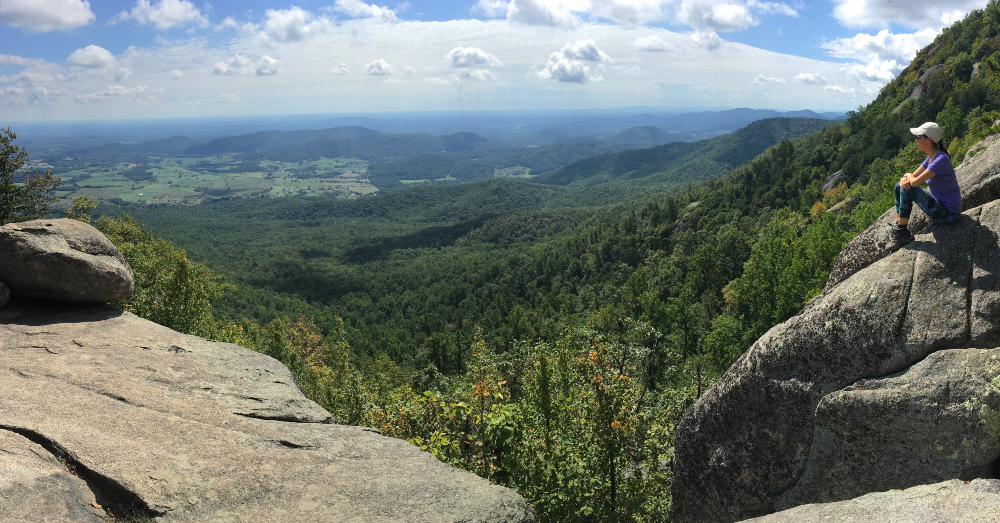Play
 Lani Furbank on Old Rag Mountain in Shenandoah National Park. Photo courtesy of subject.
Lani Furbank on Old Rag Mountain in Shenandoah National Park. Photo courtesy of subject.
Hit The Trail: What You Need to Know to Start Backpacking
August 7, 2020 @ 10:00am
In 1955, a 67-year-old woman named Emma Gatewood hiked more than 2,000 miles with a homemade knapsack, a blanket, a shower curtain and Keds sneakers. She became the first woman to successfully solo-hike the entire Appalachian Trail.
Veteran backpacker and REI employee Nelson Bruni brought up Grandma Gatewood when I asked him about what kind of gear was required to start backpacking, and who should consider giving it a try. As an enthusiastic backpacker myself, I was a little embarrassed I’d never heard of this pioneering hiker, and I was even more embarrassed thinking back to those times on the trail where I’ve complained about my state-of-the-art pack being a little uncomfortable and causing my 28-year-old shoulders to get sore.
But Bruni told me Grandma Gatewood’s story as an encouragement to anyone interested in backpacking.
“There is no perfect body type or perfect person for backpacking,” he says. “If you have the will and you can enjoy it, you can do it.”
Different from day hiking or camping at a campground, backpacking or backcountry camping is where you head out into the wilderness with everything you need on your back. Many ambitious folks set out to thru-hike the country’s longest trails, meaning completing the entire length of the trail in one continuous trip.
The most well-known are the Appalachian Trail, the Continental Divide Trail and the Pacific Crest Trail (the one featured in Cheryl Strayed’s “Wild”). They’re colloquially referred to by acronyms – the AT, the CDT and the PCT, respectively. Completing all three is considered the Triple Crown of Hiking, and Bruni is two-thirds of the way to earning this elite moniker – he’s done the AT and the PCT.
Since the AT is right in our backyard and the sky’s the limit in terms of how far you can travel, backpacking is a highly adaptable activity, especially for beginners. Casual backpackers can easily stuff a pack and get out on the trail for a day trip or even a long weekend.
“Even if you go backpacking and you go 1 mile, you’ve done more than most people are ever going to do in their life,” Bruni says.
2020 is also the perfect time to head into the backcountry, because it’s the ultimate social distancing activity – no other people for miles, bring your own everything and disconnect from screens and the accompanying stress.
If you’ve read “Wild” or talked to a long-distance backpacker, you might have heard horror stories about the physical trials of the trail. Thankfully, Bruni says, the positive memories outweigh the struggles.
“There’s a quote from ‘Cold Mountain’ [by Charles Frazier], where he talks about God’s gift to us is that we only remember the good.”
To help you get started and experience the good, Bruni shared his expertise about everything from snacks and gear to trails and safety.
Nelson’s Highlights
Best Trail: Grayson Highlands, a section of the Appalachian Trail in Southwest Virginia
Hardest Trail: Sections of the John Muir Trail in the Sierra Nevada, specifically Sequoia & Kings Canyon National Parks and crossing Kings River
Most Epic View: Atop Mount Katahdin in Maine after hiking the entire Appalachian Trail
Go-To Local Trails: Prince William Forest Park in Triangle, Virginia
Favorite Part: “Just the simplicity of it.”
Least Favorite Part: “I usually can’t sleep the first night.”
Can’t Live Without Gear Item: Buff (used as a face mask, a hat, mittens, a coffee filter in a pinch and much more)
Motivating Trail Snack: Sour Patch Kids
Best Dehydrated Meal: Backpacker’s Pantry chana masala or three-cheese mac and cheese
Gearing Up
Bruni was 19 when he first hiked a section of the AT, and he found that hardest part about getting started wasn’t the hiking itself, but the expense of investing in gear. He estimates that purchasing “the big three” – a backpack, a tent and a sleeping system (which includes a sleeping bag and pad) – can range from $500 to $1,000. These are the three most critical items for backpacking, so Bruni recommends spending your money on high quality and lightweight products.
“The lighter you can be, the more fun you’re going to have,” he says. “If you’re comfortable, you’re going to go again.”
It’s also important that your gear fits you right, so plan to visit an outdoor outfitter like REI Co-op to get expert advice on what you plan to purchase. This way, you can try on the products and evaluate their quality in person.
“Do your research. Don’t just go on to Amazon and buy the cheapest thing,” Bruni says. “If your tent is a $60 tent that you bought online from somewhere and it ends up raining and you get wet, you’re not going to be very happy about backpacking.”
However, as we learned from Grandma Gatewood, the gear doesn’t make the backpacker. You don’t have to shell out to be successful. Bruni suggests checking used gear forums online to find gently used items.
After you’ve purchased the big three, you can start to gather the other essentials, like a water filter, hiking boots and a compact camp stove. Here’s where you can be a bit more frugal and use what you may already have.
“You do not need hiking clothes,” Bruni says. “If you have soccer shorts, if you have anything quick dry. You don’t need to have a pair of zip off pants or anything like that. You can get away with, especially this time of year, just having two sets of clothes – one for camp, one for hiking.”
Beginner’s Packing List
The Big Three: Backpack, Tent, Sleeping system (sleeping bag + pad)
Other Essentials
Water filter | Water bladder or bottles | Food | Camp stove + fuel | Fire starter (lighter/matches/firesteel)| Cooking pot | Cup and/or bowl | Spork | Sponge + biodegradable soap | Dish towel | Food storage system (p-cord + stuff sacks or bear canister) | Maps + compass | Headlight | Multi-tool | First-aid kit | Minimal toiletries (including toilet paper) | Sealable trash bag | Hiking poles | Boots + socks | Quick-dry clothing | Bandana Buff | Sun hat | Sunscreen | Insect repellent
Planning a Trip
Before you finally hit the trail, be sure to do your research and plan ahead. You’ll want to take into consideration everything from setting up camp to cleaning up after yourself. It’s a great idea to have a test run close to home first. Put all your gear in your pack and make sure it fits and isn’t too heavy.
“35 pounds is what I would try to encourage people to shoot for, just because it’s manageable for almost everyone,” Bruni says. “A 50- to 60-liter pack.”
Do a several mile day-hike on a local trail or even in your neighborhood to get used to how the full pack feels on your back and see if your boots are truly comfortable.
Then take your gear out to your backyard or a nearby park and practice setting up your tent, starting your stove, using your compass, hanging your food in a tree to keep it away from bears, administering first aid and anything else you feel uneasy about.
After that, you can get to the specifics of your first trip. Bruni recommends something short and simple to start, like heading into the Chopawamsic Backcountry Area in Prince William Forest Park in Triangle, Virginia.
“Go there before you go to Shenandoah – 1.5 miles on a pretty flat trail is much more forgiving, and if you forgot a lighter, it’s easier to get to your car than being 6 miles down on Jeremy’s Run.”
Wherever you decide to go, plan out your route in advance and print or purchase maps. Know where the water sources are along the way. Buy and pack enough food for the length of your trip, plus a little extra for security.
Plus, know the rules for where you’re heading. In Shenandoah National Park, for example, permits are required for backcountry camping and fires are never allowed. In the George Washington National Forest, on the other hand, permits are not required and safe fires are allowed when a ban is not in place.
Bruni recommends doing research and looking for maps at sources like Shenandoah National Park’s website, The Hiking Project and Potomac Appalachian Trail Club.
When it comes to navigation, he says having a GPS is great for safety and as a guide, but a printed map and compass are vital failsafes.
“Never rely on the GPS because you can get into some pretty deep areas where the GPS will just not be functioning correctly, especially this time of year with the canopy,” he says.
No matter where you end up, be a good steward of the outdoors, for the sake of wildlife and other hikers. “I definitely encourage anyone getting ready to go out to really review [the] Leave No Trace [outdoor stewardship guidelines] and figure out how to poop in the woods, because I think any of us using the trails now are seeing a lot more toilet paper,” Bruni says.
The bottom line is: take everything you brought in, out with you.
The Seven Principles of Leave No Trace
Review and practice these outdoor stewardship guidelines when you head out on a backpacking trip.
Plan ahead and prepare.
Travel and camp on durable surfaces.
Dispose of waste properly.
Leave what you find.
Minimize campfire impacts.
Respect wildlife.
Be considerate of other visitors.
Visit www.lnt.org to read about the principles in detail.
Safety Considerations
As with any outdoor activity, it’s important to take precautions to keep yourself safe. Bruni always carries a basic first-aid kit stocked with the essentials, like an antihistamine, an analgesic, bandages, gauze, antiseptic wipes, antibacterial ointment, gloves, a CPR mask and a chlorine tablet.
Before you leave, share your trip plan with a trusted individual, so someone knows where you’ll be and when you’re set to return.
Research the region to know what to expect. Bruni says many folks think of bears as the biggest threat, but in our area, raccoons and poison ivy are probably going to cause you more trouble.
“I’ve never had a negative bear incident, but I’m also very big on hanging my food and not eating in my tent and keeping a clean camp,” he says. “If I see cubs, [I step] back. [I’ll make] noise if I think I’m in an area where bears might be. But I don’t carry bear spray in Shenandoah.”
Hydration is another key consideration. Always carry enough water with you or have a plan for where to fill up. Filter water before drinking it, even if it seems like the source is clean. In the summer heat, Bruni advises caution.
“Considering that almost no one stays hydrated enough on just a normal backpacking trip, the idea of packing in this sort of weather could easily put someone not acclimated to being outside for a prolonged period of time at serious risk.”
He suggests keeping the trip on the shorter side and opting for a trail along a creek or run where water and shade are in abundance.
“With this weather, a little homework on what to do in the backcountry during a thunderstorm would also be recommended,” he adds.
There are lots of resources for learning more about backpacking. Experts like Bruni are available to answer questions at REI stores, and their website has lots of helpful information. The Potomac Appalachian Trail Club is a great place to meet up and hike with others.
The most important piece of advice Bruni has for new hikers is the short and sweet kid-friendly version of Leave No Trace principle number one. “Know before you go. It’s just super simple,” he says.
Find Bruni and more advice here: www.rei.com/stores/woodbridge and www.rei.com/learn/expert-advice.
More backpacking resources below:
Appalachian Trail Conservancy: www.appalachiantrail.org
Brown People Camping: www.brownpeoplecamping.com
Granite Gear Grounds Keepers: www.thegroundskeepers.org
Guthook Guides app: www.atlasguides.com
The Hiking Project: www.hikingproject.com
NativesOutdoors: www.natives-outdoors.com
Shenandoah National Park’s website: www.nps.gov
Potomac Appalachian Trail Club: www.patc.net
Wilderness Press’ “Top Trails: Shenandoah National Park:” www.wildernesspress.com
Note: this article contains Amazon affiliate links. When you buy something through our affiliate links, District Fray Magazine earns an affiliate commission.
Enjoy this piece? Consider becoming a member for access to our premium digital content and to get a monthly print edition delivered to your door. Support local journalism and start your membership today.







